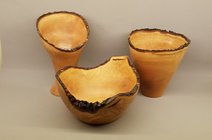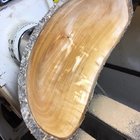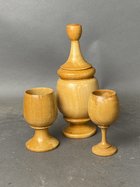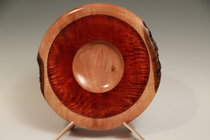A while back I got advice on sanding some natural edge once turned pieces that developed a heavy oxidation layer (my term, not sure correct) while drying. I'm back looking for advice. Bradford Pear is common here and I get it from time to time. Great to turn but horrible to sand. When exposed to the air it quickly develops a bright, dark and deep orange surface. Per Robo's method I soak them in the water/liquid detergent bath for a couple of days after turning, then let dry. It makes them easier to sand but even then when sanding it takes a LOT of effort with 80 grit to get through the fuzzy orange surface layer and then it will sometimes break through completely and expose the pale colored wood underneath. Sanding to continue to get all the orange tone out of it would take a lot more time and 80 grit discs than I want to commit to. If you don't get all of the surface layer sanded well it looks dirty and dingy. A tough balance. The pic attached is one that has several places where the pale wood had been exposed. Sanded very smooth to 180. Anyone else worked with green Bradford Pear? I'm not doing any more natural edge pieces unless I come up with the trick that eliminates this for me. Not worth the effort for wood that's not even that great of a look.
-
It's time to cast your vote in the December 2025 Turning Challenge. (click here for details) -
Congratulations to Pat White for "Sicilian Mosaic" being selected as Turning of the Week for December 29, 2025 (click here for details) -
Welcome new registering member. Your username must be your real First and Last name (for example: John Doe). "Screen names" and "handles" are not allowed and your registration will be deleted if you don't use your real name. Also, do not use all caps nor all lower case.
You are using an out of date browser. It may not display this or other websites correctly.
You should upgrade or use an alternative browser.
You should upgrade or use an alternative browser.
Sanding Bradford Pear
- Thread starter Randy Anderson
- Start date
Cherry is another wood that oxidizes really fast. I run into that with my madrone as well. I don't bother with sanding out the oxidation. The color splotching adds to the 'character' of the bowl, It will even out over time. As you said, it is a lot of extra work. I guess you could use a goose neck card scraper, but again, that is a lot of work. I just make sure to sand out any tear out...
robo hippy
robo hippy
I do get the same sort of layer on cherry but it's easier to get it off and down to the clean surface. The bradford is just a real pain to get there. Your advice is like my local turning buddy says, quit over thinking it. Sand till a good surface and just call it character.
great wood BP.....put in drawer 5 / 6 days then sand....
I put in a paper bag for a lot longer than that right after turning and soaking so don't think it's exposure to light that aggravates it. I have a lot left, big pieces so thinking some traditional bowls with some details and move on. Lots of other wood to work through for natural edge.
I have not seen anything different about sanding BP. I have turned at least a dozen pieces where I started green, left the surface unsanded, or at most sanded to 120 grit when green, let dry, and then finish sanded. At this point the piece is no longer round and I sand off the lathe. My favorite way is to put a sanding mandrel in my drill press, and hold the piece with two hands as I move it around under the spinning disk. Sanding has not been that difficult: certainly never went through more than one 80 grit disk per piece, probably 2 pieces per disk. I have not seen the issue you show of pale areas mixed with darker areas. Two other things to consider: 1, after finish sanding, the piece will darken again. I think you could try to leave the pale areas for a few days and see if the color evens out. 2. Add some oil and see if that evens out the color. Wet sanding BP with walnut oil works extremely well for me. After the oil cures, Beall buffing produces a silky smooth, semi gloss surface.
Michael, what grit do you wet sand at? I considered giving that a try.
I dry sand through 180 grit and wet sand 240- 400 grit.
John, nice pieces and the oxidation does add character. I was wanting to have that similar look on the bowl and hoping it will now blend a bit better as it ages. Will see. I have a number of large pieces left so plan to let some of them age and try again. I did finish one very large natural edge a few days ago where the oxidation color blended well so there is hope although it did take a lot more sanding than I wanted. I've told others that turning green bradford pear can spoil you. It turns and makes shavings just like in the movies. Fun to turn green.
I've told others that turning green bradford pear can spoil you. It turns and makes shavings just like in the movies. Fun to turn green.
Green Bradford pear is indeed fun to turn. When dry it also cuts beautifully, yielding a fine surface from the gouge.
- Joined
- Feb 6, 2010
- Messages
- 3,464
- Likes
- 2,536
- Location
- Brandon, MS
- Website
- threeringswoodshop.square.site
You can take that oxidized layer off, but will come back when the project is a couple years old. Probably don't want to wait that long though.
Randy, it's been a while since I last turned a BP but I didn't have any issues that I remember. In fact my recollection is that it was a delight to turn. These pictured were turned several years ago. But I recenly required some big, 14" diameter pieces that I hope to get into in the next few months. I'll remember this thread and let you know what I encounter.


Nice pieces Dave and yes, it's fun to turn. One large natural edge piece I did ended up with a look like yours have. The next small one has the same look but some large places that sanded through to the much paler color wood. I've just accepted it as part of the look.
As an experiment you try soaking pieces in denatured alcohol in a covered container for a few days Instead of detergent. Then dry slowly to evaporate the alcohol from the wood before sanding. I’ve done this before with cherry bowls, and they kept the oxidation down along with keeping a redder hue.
My pear normally ages before I can get to it like John, but I understand why you want it kept green when turning a natural edge bowl.
My pear normally ages before I can get to it like John, but I understand why you want it kept green when turning a natural edge bowl.



